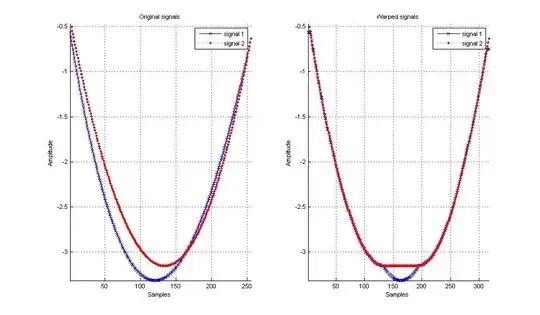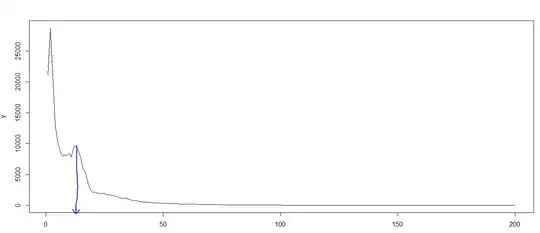You can think of it as a problem of analytically locating the local maxima
that are graphically observed. The code below locates those maxima by means of a one-dimensional optimization algorithm that is applied across overlapping intervals that cover the entire x-axis. At each interval the objective function is defined by spline interpolation of the sample periodrogram.
I think there is a more complete implementation of this idea somewhere in a package or post, but I could not find it.
As an example, I take the sample periodogram for the logs of
the "AirPassengers" data:
sp <- spectrum(log(AirPassengers), span = c(3, 5))
Next I define the objective function, the intervals that are checked for the presence of local maxima and some thresholds for the gradient and Hessian that will be used to decide whether or not to accept the solution as a local maximum.
# objective function, spline interpolation of the sample spectrum
f <- function(x, q, d) spline(q, d, xout = x)$y
x <- sp$freq
y <- log(sp$spec)
nb <- 10 # choose number of intervals
iv <- embed(seq(floor(min(x)), ceiling(max(x)), len = nb), 2)[,c(2,1)]
# make overlapping intervals to avoid problems if the peak is close to
# the ends of the intervals (two modes could be found in each interval)
iv[-1,1] <- iv[-nrow(iv),2] - 2
# The function "f" is maximized at each of these intervals
iv
# [,1] [,2]
# [1,] 0.0000000 0.6666667
# [2,] -1.3333333 1.3333333
# [3,] -0.6666667 2.0000000
# [4,] 0.0000000 2.6666667
# [5,] 0.6666667 3.3333333
# [6,] 1.3333333 4.0000000
# [7,] 2.0000000 4.6666667
# [8,] 2.6666667 5.3333333
# [9,] 3.3333333 6.0000000
# choose thresholds for the gradient and Hessian to accept
# the solution is a local maximum
gr.thr <- 0.001
hes.thr <- 0.03
Now run the optimization algorithm for each interval. The gradient and Hessian are computed numerically by means of the functions grad and hessian from package numDeriv.
require("numDeriv")
vals <- matrix(nrow = nrow(iv), ncol = 3)
grd <- hes <- rep(NA, nrow(vals))
for (j in seq(1, nrow(iv)))
{
opt <- optimize(f = f, maximum = TRUE, interval = iv[j,], q = x, d = y)
vals[j,1] <- opt$max
vals[j,3] <- exp(opt$obj)
grd[j] <- grad(func = f, x = vals[j,1], q = x, d = y)
hes[j] <- hessian(func = f, x = vals[j,1], q = x, d = y)
if (abs(grd[j]) < gr.thr && abs(hes[j]) > hes.thr)
vals[j,2] <- 1
}
# it is convenient to round the located peaks in order to avoid
# several local maxima that essentially the same point
vals[,1] <- round(vals[,1], 2)
if (anyNA(vals[,2])) {
peaks <- unique(vals[-which(is.na(vals[,2])),1])
} else
peaks <- unique(vals[,1])
The located peaks in this case are the following:
peaks
# [1] 0.06 1.00 2.01 2.99 4.00 4.98
Graphically we can see that in this example they match well with the peaks observed in the plot of the periodogram:
plot(sp$freq, sp$spec, log = "y", type = "l")
abline(v = peaks, lty = 2)


